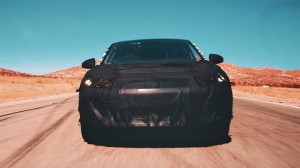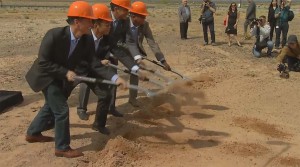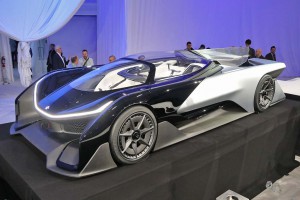
Faraday Future plans to go full speed ahead with its new sport-ute concept, which it will show at the upcoming Consumer Electronics Show.
Faraday Future, start-up battery-carmaker, was hoping to make some big news next week at the annual Consumer Electronics Show – but the story may be quite a bit different than the California-based company had intended.
The CES event is still expected to take place, with Faraday planning to reveal its first production model. But the splashy media event could be hijacked by other issues that raise serious questions about the start-up’s long-term viability.
The latest setback comes with word that Ding Lei, the unofficial CEO for Faraday, has left his post. He is one of a growing list of executives who have been heading for the exit in recent months. Exactly why the exodus is unclear, but Faraday’s financial fortunes appear to be crumbling. The company recently halted work on its $1 billion Las Vegas assembly plant and has now been sued for failing to deliver payments due to a key contractor on the plant project.
It has even been hit with a lawsuit for unpaid rent on a warehouse, according to Buzzfeed News.
(Despite financial problems, Faraday still set to debut first model at CES. For more, Click Here.)
The mounting financial issues and the halt of work on the assembly plant recently led the Nevada state treasurer to describe Faraday as a “Ponzi scheme.”
Whether these issues are enough to bring the company down is also uncertain, but it certainly didn’t help when Jia Yueting, the Chinese billionaire backing both Faraday Future and LeEco, another battery-car start-up, said he was having cash flow problems.
Faraday is, to say the least, an unusually managed company. Since it was founded, it has had no official chief executive, though Lei was considered its acting boss, while also working for LeEco, which he joined in 2015.
The reason behind his departure from Faraday could signal further troubles at the company – or he may be making way for a full-time chief executive. That is likely to be one of the big questions during the company’s CES media event.
Faraday has lost a number of senior employees in recent months, six in October alone. Then, in the last week, two other key defections were revealed. Marco Mattiacci, a former Ferrari exec, had been serving as Faraday’s chief brand and commercial officer, while former Volkswagen manager Joerg Sommer resigned from his post as the battery-car company’s product marketing VP.
(Click Here for more about Faraday Future.)
Beyond the departures, Faraday has yet to give a clear indication of when it will restart work on the Nevada assembly plant for which it broke ground last April. A key contractor on the project has sued the company for unpaid bills.

Officials dig in at the May groundbreaking ceremony for the new Faraday Future plant.outside Las Vegas.
But Faraday has been facing plenty of other legal headaches. It settled one lawsuit with supplier Futuris Automotive, which had sued for $10 million in unpaid bills.
Further complicating matters, Faraday appears to be potentially on the hook as the guarantor of a $250 million purchase by LeEco of property previously owned by Yahoo.
Considering Faraday Future only got into business three years ago, it’s no surprise it has faced some serious challenges, especially considering the speed with which it hoped to come to market – the first production vehicles promised by 2018.
On the positive side, there’ve been numerous sightings of lightly disguised Faraday Future prototypes, suggesting that development work continues despite recent setbacks.
(Chinese-funded Faraday Future denies halting work on Nevada plant. Click Here for the story.)
There should be a lot more details emerging next week at CES, though Faraday’s first production model won’t be the only thing in the spotlight.

